Lal R., Shukla M.K. Principles of Soil Physics
Подождите немного. Документ загружается.


17.10.2 Microbial Processes and Heat Evolution
Diverse communities of organisms are present in soil. Variations of microbial population,
distribution and activity are a function of depth and type of soil including structure,
texture, and water status (Misthustin, 1956). Metabolism is defined as the sum of all
chemical reactions occurring within a living organism. Catabolic reactions are exergonic
or energy-releasing reactions, which break down more complex molecules, usually by
hydrolysis, into simpler components (e.g., chemical processes of digestion). Anabolic
reactions are endergonic or energy requiring and build more complex molecules, usually
by condensation, from subunit components. The energy for anabolic reactions is provided
by catabolic reactions. Microorganisms decompose the organic matter present in the soils
and heat energy is released. An example of an exergonic reaction is the fermentation of
alcohol as follows:
C
6
H
12
O
6
→2C
2
H
5
OH+2CO
2
+226 kJ
(17.22)
17.10.3 Chemical Reactions and Heat Evolution
Oxidation and reduction reactions (REDOX reactions) are always coupled in biological
systems. Oxidation reactions are exothermic (or exergonic) and release energy, whereas
reduction reactions are endothermic (or endergonic) and harness energy. Chemical
reactions may be viewed in terms of the amount of energy required by the reaction at
various stages. A convenient way to do this is with an energy hill diagram. In these
diagrams, the total amount of energy, both kinetic and potential in the chemicals involved
in the reaction, is plotted as a function of time. Conversion of sulfur (S) to sulfur dioxide
(SO
2
) and to sulfuric acid (H
2
SO
4
) are examples of exothermic processes.
S+O
2
→S0
2
(17.23)
2SO
2
+O
2
→ 2SO
3
(17.24)
SO
3
+H
2
O→H
2
SO
4
(17.25)
The above chemical reaction releases about 178 Kcal/mole of energy (Bohn et al., 1934).
Chemical reactions are known as exothermic when the chemical products of the reaction
have less energy than the starting materials. Another example of an exothermic reaction
is burning wood or a burning match. Wood is mainly cellulose and has a lot of chemical
energy. The products of burning (e.g., CO
2
and H
2
O) have much less energy because the
net balance of the energy is converted into light and heat.
Chemical reactions that lead to products having more energy at the end than at the
beginning are called endothermic. Endothermic reactions typically involve the synthesis
of complex molecules from simple ones. Examples of endothermic reactions are cells
making proteins from amino acids and photosynthesis in plant cells. In photosynthesis,
CO
2
and H
2
O, which are the starting materials for photosynthesis, have less energy than
Principles of soil physics 494

the final product, i.e., carbohydrates
(http://old.jccc.net/~pdecell/metabolism/energyhill.html).
17.11 ENERGY BALANCE OF SOIL
Net radiation is the sum of all incoming minus all outgoing radiation on Earth’s surface.
Steady state one-dimensional heat energy balance at the soil surface or crop canopy can
be written as
Net heat energy arriving at surface
− net heat energy leaving surface=0*
(17.26)
Equation (17.26) disregards the transient energy changes due to heating or cooling of soil
surface and lateral heat energy inputs. Heat transfer
* Except in a greenhouse, where net heat energy leaving the surface is smaller, therefore, Eq.
(17.26) is not satisfied.
from the soil surface takes place as (i) convective heat flux (H
c
), (ii) soil heat flux (J
H
)
and (iii) latent heat flux (L*E). H
c
represents the transport of warm air from the soil
surface to the atmosphere vertically above it. The J
H
represents the vertical transport of
heat into the soil, and L*E denotes evaporation and subsequent transport of water vapor
from the soil surface (L is the latent heat of vaporization and E is the evaporation rate).
The net radiation received by the soil surface is transformed into heat, which warms soil
and air and vaporizes water. Therefore, under steady state conditions the heat balance
equation can be written as
R
N
=H
c
+J
H
+L*E
(17.27)
Combining Eqs. (17.19) and (17.27) provides the total surface energy balance as follows
(1−α)Rs+Rnt−(H
c
+J
H
+L*E)=0
(17.28)
17.12 HEAT CAPACITY OF SOIL
The heat capacity of soil as defined in Sec. 17.5.1 is the amount energy required to
change the temperature of a body by 1°C by heat adsorption or release. The relationship
between volumetric and gravimetric heat capacities for a dry soil is described in Eq.
(17.8), which is rewritten below:
C
v
=ρ
b
*C
g
(17.8)
and for a wet soil
Soil temperature and heat flow in soil 495

(17.29)
where
is wet bulk density, w is gravimetric water content, and θ is volumetric water
content. The C
v
is dependent on composition of solid phase, which constitutes mineral
and organic matter, bulk density, and water content of soil. The total C
v
is calculated by
summing the heat capacities of various constituents, weighted according to their volumes
(de Vries, 1975)
C
v
=Σ(f
si
C
si
+f
w
C
w
+f
a
C
a
)
(17.30)
TABLE 17.7 Thermal Conductivity and Heat
Capacity of Gases (Oxygen at 25°C, 1 atm), Water
(26.7°C), Quartz (37.8°C), and Sandstone (100°C)
Gas Thermal conductivity (k
T
) (10
−6
cal cm
−1
s
−1
°C
−1
)
Heat capacity (C
g
) (cal
g
−1
°C
−1
)
Air 62.2 0.25
Carbon
dioxide
39.67 –
Oxygen 63.64 0.219
Water 42.57 0.998
Quartz (C-
axis)
6.4 0.18
Sandstone 3.82 0.26
Iron
Source: Adapted from Handbook of Chemistry and Physics, 1988–89.
where f is the volumetric fraction of each constituent phase, subscript s, w, a, and f stand
for solid, water, air, and number of components in a given phase. The gravimetric heat
capacity is the ratio of volumetric heat capacity and particle density (Table 17.7). The
heat capacity of loam, sandy loam, sandy clay loam, a clay loam, and clay soil is given in
Table 17.8. The heat capacity for each of the components solid, water, and air is the
product of their particle density and specific heat or heat capacity per unit mass, i.e.,
C
si
=ρ
si
C
mi
, C
w
=ρ
w
C
mw
, and C
a
=ρ
a
C
ma
. In general, the contribution of air is almost
negligible because of the very small density and is ignored. The solid phase is divided
into two components: mineral (m) and organic matter (o). Eq. (17.30) can be rewritten as
C
v
=∑(f
m
C
m
+f
o
C
o
+f
W
C
W
)+f
o
C
o
+f
w
C
w
)
(17.31)
Principles of soil physics 496

17.13 THERMAL CONDUCTIVITY
The thermal conductivity (k
T
) is defined as the quantity of heat transferred through a unit
cross-sectional area in unit time under a unit temperature gradient. The K
T
of soil depends
upon the volumetric proportions of the solid, liquid, and gaseous phase of the soil
medium. The other factors, which influence K
T
, are the size and arrangement of solid
particles, and interfacial contact between solid and liquid phases. The K
T
values of some
materials is presented in Tables 17.7 and 17.9, which show that air has a much lower K
T
than water and solid, therefore, high air content reduces the thermal contact between soil
TABLE 17.8 Heat Capacity of Some Nigerian
Soils
Soil texture Heat capacity (calg
−1
°C
−1
)
Sandy loam 0.322
Sandy clay loam 0.350
Loam 0.279
Clay loam 0.224
Clay 0.248
Source: Modified from Ghuman and Lal, 1985.
TABLE 17.9 Range and Averages of Thermal
Diffusivity and Thermal Conductivity of Soil
Particles
Thermal diffusivity ×10
−3
(cm
2
s
−1
)
Thermal conductivity ×10
−3
(calcm
−1
s
−1
°C
−1
)
Soil
type
Moisture
state
Range Average Range Average
Dry 3.5–1.5 2.23 0.55–0.37 0.42 Sand
Wet 12.6–4.4 8.0 4.35–3.7 4.02
Dry 1.8–1.2 1.5 0.37–0.17 0.26 Clay
Wet 11–3.2 5.97 3.5–1.4 2.69
Source: From Geiger, 1965; Nakshabandi and Kohnke, 1965; and van Duin, 1963.
particles and reduces the K
T
of soil. On the other hand, an increase in bulk density of soil
lowers the porosity and improves the thermal contact between soil particles and increases
K
T
and D
T
(cm
2
s
−1
). The increase in water content of the soil also improves the thermal
contact between soil particles and increases K
T
as well as D
T
.
Soil temperature and heat flow in soil 497
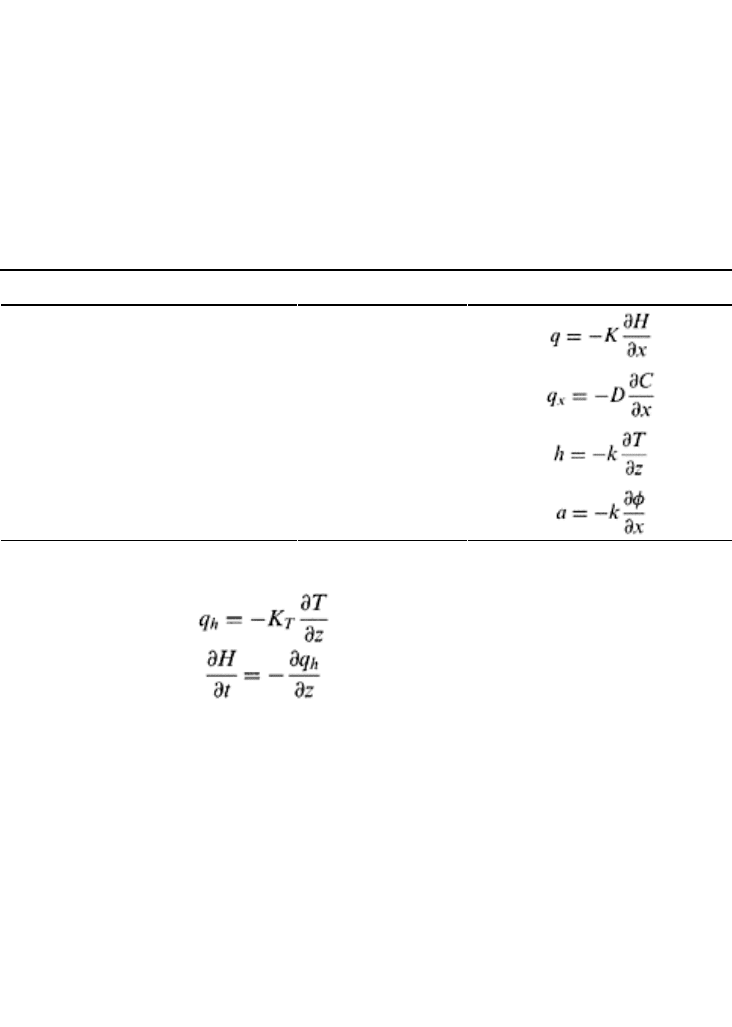
17.14 HEAT FLOW IN SOILS
Fourier (1822) analyzed the heat conduction in solids and developed a mathematical
relationship, which is analogous to the diffusion equation by Pick (see Chapters 16 and
18), conduction of fluid flow in porous media by Darcy (refer to Chapters 12 and 13), and
conduction of electricity by Ohm (Table 17.10). The first law of heat conduction is
known as Fourier’s law and under steady state condition in one-dimension, the heat flux
density (qh, Jm
−2
s
−1
) equation and the heat energy balance equation for
TABLE 17.10 The Analogous Laws of Water, Air,
Heat, and Electricity Flow
Process Law Equation
Water movement Darcy’s
Air movement Fick’s
Heat movement Fourier’s
Electric flow Ohm’s
homogeneous soils is expressed as follows:
(17.32)
(17.33)
where H is the volumetric heat content (Jm
−3
), and volumetric heat capacity of soil (C
v
) is
equal to dH/dT. The early developments of heat conduction dealt with dry media, i.e.,
solids only (Carslaw and Jaeger, 1959). The theory was later expanded to soils containing
water. At first the heat flow was studied for homogeneous soils with constant C
v
and K
T
.
Combining these two equations [(17.32) and (17.33)], which ignores the existence of a
sink or source term, results in general heat conduction equation. These equations can be
solved numerically for nonhomogeneous soil profiles by assuming that heat transfer takes
place by conduction only. The addition of water complicates the process as water may
evaporate and condense. As the heat energy inside a soil matrix is transported by
convection (by flowing water, air, and latent heat), conduction, and radiation. The first
two are the most important heat transport process through soil. The convection can be
represented as given by Eq. (17.21). The expression for net flux of heat through soil can
be written as
Principles of soil physics 498
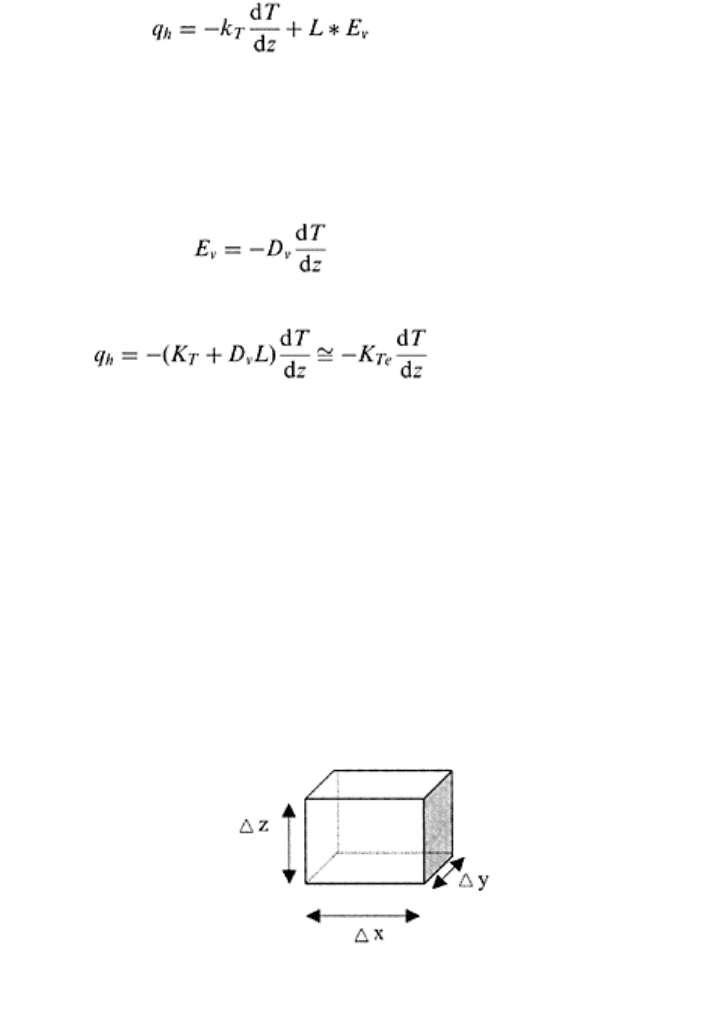
(17.34)
where E
v
is the water vapor mass flux (gcm
−2
s
−1
). The temperature gradient across a
moist soil results in movement of water both as liquid and gas along with heat, therefore,
the effective value of K
T
exhibits a temporal variation and therefore cannot be measured
in the soil directly (de Vries, 1958). If D
v
is the thermal vapor diffusivity then water
vapor flux in soil in one-dimension flow where relative humidity is above unity can be
written as
(17.35)
Transferring Eq. (17.35) into Eq. (17.34) results in
(17.36)
where K
Te
is the effective thermal conductivity of the porous medium, which includes the
effects of conduction and convection of latent heat.
17.15 HEAT CONSERVATION EQUATION
The heat conservation equation for a small cubic soil matrix (Fig. 17.7) can be derived by
accounting for the amount of heat energy entering a system, leaving a system, and change
in the heat energy of a system. Mathematically a heat balanced equation can be written as
follows (Jury et al., 1991)
The amount of heat energy entering soil matrix
= amount of heat leaving the soil matrix
+ increase in heat energy of the soil matrix
+ loss of heat energy from the soil matrix.
(17.37)
FIGURE 17.7 Schematic of a soil
matrix for heat conservation equation.
Soil temperature and heat flow in soil 499

Assuming the heat flow is in z-direction, the one-dimensional heat flow in vertical
direction during time interval ∆t through the soil matrix (Jury et al., 1991; Scott, 2000)
(17.38)
where h is the heat flux at the average time t+(∆t/2) and ∆x and ∆y are the cross-sectional
area of the soil matrix. The amount of heat flowing out of the matrix for the same time
interval
(17.39)
The net change in H within the soil matrix
(17.40)
where H is at the middle or z+(∆z/2). If the amount of heat lost from the soil matrix per
unit system is r
s,
the total heat loss
= r
r
∆x∆y∆z∆t
(17.41)
Transferring Eqs. (17.38), (17.39), (17.40), and (17.41) into Eq. (17.37), and after
rearranging and assuming that ∆Z and ∆t→0, the resultant equation is known as the
differential form of heat conservation equation (Jury et al., 1991; Scott, 2000)
(17.42)
The H can also be expressed as a function of volumetric heat capacity of soil C
v
and
temperatures
H=C
v
(T−T
ref
)
(17.43)
where T
ref
is the reference temperature at which H=0. Transferring Eq. (17.43) into
(17.42), and assuming C
v
a constant, we obtain
(17.44)
if k
t
is assumed to be independent of z then following heat flow equation is obtained.
(17.45)
Principles of soil physics 500
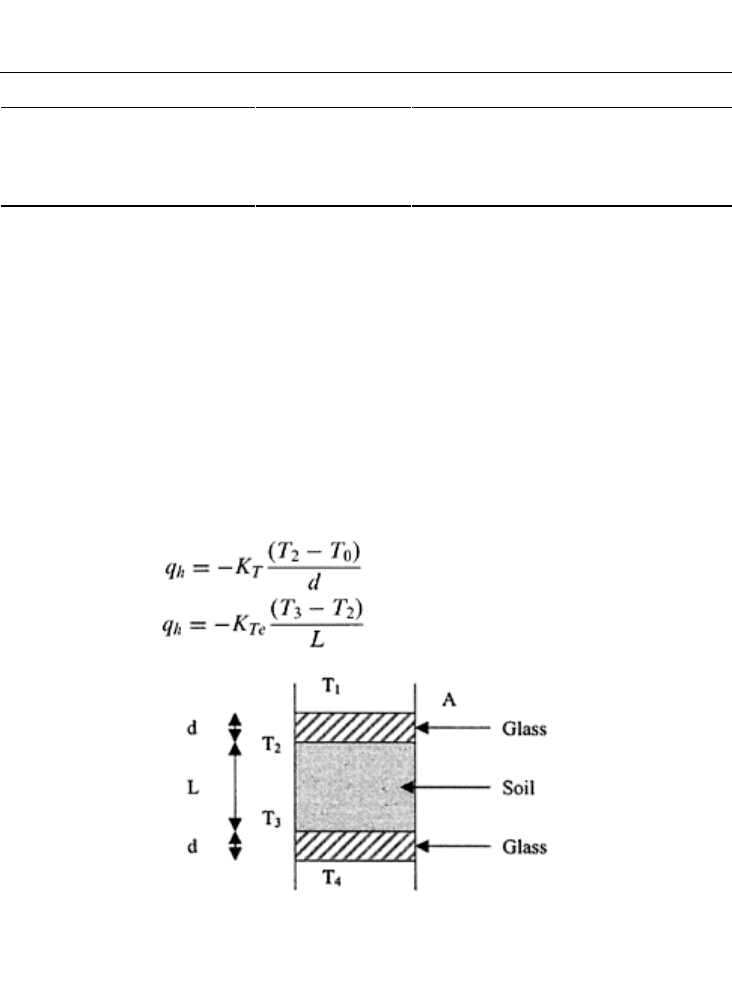
where D
T
=K
T
/C
V
, and is known as soil thermal diffusivity (L
2
T
−1
or m
2
s
−1
). D
T
can be
expressed in three different ways for soil water diffusivity, diffusion in air, and soil
thermal diffusivity as follows:
Definition Equation Unit
Soil water diffusivity D
θ
=K
θ
(dΦ
m
/dθ) cm
2
s
−1
or L
2
T
−1
Diffusion coefficient in air D
s
=D
0
*0.66*f
a
cm
2
s
−1
or L
2
T
−1
(see Chapter 18)
Soil thermal diffusivity D
T
=K
T
/C
V
cm
2
s
−1
or L
2
T
−1
17.16 MEASUREMENT OF THERMAL CONDUCTIVITY OF
SOIL
Similar to hydraulic conductivity (K
s
), thermal conductivity (K
T
) can be measured using
the steady state method or transient methods. Let us assume a soil column of thickness L
placed between two glass plates of thickness d. The outer surface of each of these two
plates is at constant temperature. The temperature is measured at several different
positions as shown in Fig. 17.8. Let us assume the datum at point A, i.e., z=0 at A
1
and
that heat flux through soil and glass plates is equal, glass and soil are in good contact, and
lateral movement of heat is negligible. If the temperature measured at the plate at A is T
0
,
then according to Fourier’s law, the heat flux across the plate and soil column can be
written as
(17.46)
(17.47)
FIGURE 17.8 Apparatus for
measurement of thermal conductivity
under steady state.
Soil temperature and heat flow in soil 501
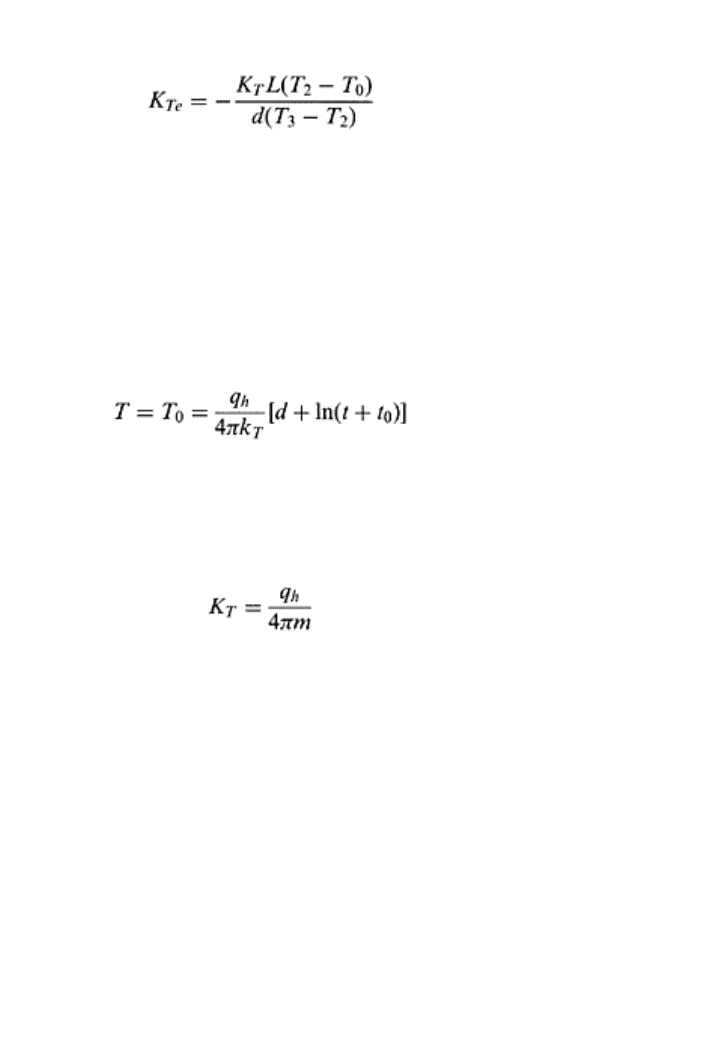
where K
Te
is the effective thermal conductivity of porous media. Equating these two
equations [(17.46) and (17.47)] and rearranging them gives the expression for effective
thermal conductivity as follows
(17.48)
The steady state methods are useful for measurement of K
T
in the laboratory. The basic
drawback of this method is that a nonuniform profile within the column is created due to
the redistribution of water under the influence of a steady state temperature gradient (Jury
and Miller, 1974). The transient method for the measurement of K
T
can be used in situ
and does have the drawback of the steady state method (De Vries and Peck, 1968). The
method consists of a thin metal wire, which serves a heat source. The wire and the
sensors for temperature measurement (for example thermocouples) are kept inside a
cylindrical tube, which is inserted into the soil. The flow of heat takes place radially from
the wire and the temperature of the thermocouple probe in contact with the soil is given
by the following equation (Carslaw and Jaeger, 1959)
(17.49)
where T
0
is the temperature at t=0, T−T
0
is rise in temperature, q is heat flowing per unit
time and length of wire, d is a constant, which depends on the location of thermocouple,
and t
0
is a correction constant, which depends upon the dimensions of the probe. The
equation (17.49) can be rearranged for t > > > t
0
and the K
T
can be calculated by the
following relationship
(17.50)
where m is the slope measured by plotting T versus ln(t). The q
h
is calculated from the
current (I) applied to the wire and the measured resistance per unit length of wire.
17.17 MANAGEMENT OF SOIL TEMPERATURE
Soil temperature can be managed in a number of ways, which includes mulching, tillage,
irrigation, drainage, cover crop or shading, and application of dark or light powder. The
management options depend whether the temperature of soil needs to be increased or
reduced. The duff layer, which is the thatch of plant material on the surface, reduces the
frequency of freeze-thaw cycles in the seed zone, maintains aggregates, and prevents
crusting. Different types of mulches are used to either lower or raise the soil temperature,
depending upon the need. Light-colored mulches (e.g., chopped straw, plastic mulches)
reflect a portion of incoming solar radiation and reduce the amount of radiant flux
reaching the soil surface, thus lowering the soil temperature (Fig. 17.9). On the other
hand, application of thick and dark mulches (e.g., charcoal or bitumen) enhance the soil
temperature. Dark plastic mulch absorbs most of the radiant solar energy but transmits
Principles of soil physics 502
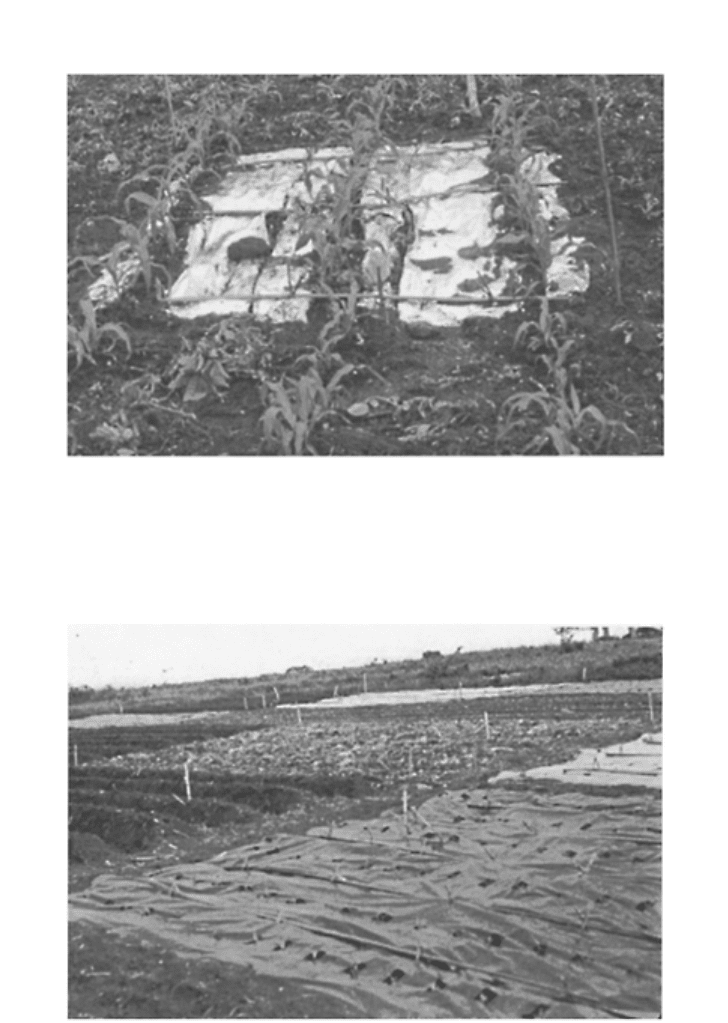
very little to the soil, keeping the soil cool (Fig. 17.10). On the other hand, transparent
plastic mulch transmits short-wave (visible
FIGURE 17.9 A light-colored mulch
(aluminium foil) decreases soil
temperature. (Lal, 1975, field
experiments.)
Soil temperature and heat flow in soil 503
